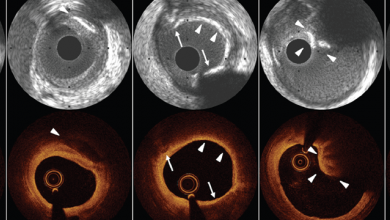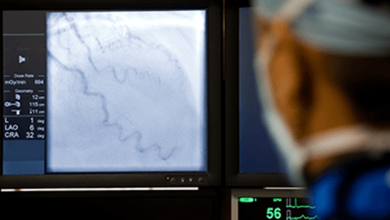Search results
Author(s):
Raoul Bonan
,
Anita W Asgar
Added:
3 years ago
Coronary angioplasty has revolutionized the treatment of coronary artery disease. Over the past two decades the field has seen numerous innovations in an attempt to perfect the percutaneous management of coronary atherosclerotic disease. The development of coronary stenting was a major advance in preventing elastic recoil and treating dissections following balloon angioplasty.1 Unfortunately,…
View more
Author(s):
Andres Vasquez
,
Neville Mistry
,
Jasvindar Singh
Added:
3 years ago
Introduction
Intravascular ultrasound (IVUS) has enhanced our understanding of atherosclerotic plaque morphology, and provides a unique opportunity to guide cardiovascular interventions and evaluate the results of these interventions. IVUS is safe, cost efficient and effective in guiding clinical decisions and cardiovascular interventions and improves outcomes when used during coronary artery…
View more
Provisional Stenting Tricks
Author(s):
Francesco Burzotta
,
Carlo Trani
Added:
3 years ago
Article
Author(s):
Yasushi Ueki
,
Tatsuhiko Otsuka
,
Kiyoshi Hibi
,
et al
Added:
3 years ago
Heavily calcified coronary artery lesions hinder device delivery and limit stent expansion, which is the most relevant predictor of stent failure. This may result in low procedural success and poor clinical outcomes. Coronary angiography has a limited ability to detect calcifications when planning an optimal percutaneous coronary intervention (PCI) strategy. Intracoronary imaging can provide…
View more
Author(s):
Yohei Sotomi
,
Richard A Shlofmitz
,
Antonio Colombo
,
et al
Added:
3 years ago
From the early days of percutaneous coronary intervention (PCI) it became apparent that the presence of severe coronary calcification was a predictor of worse clinical outcomes. In the era of plain old balloon angioplasty, severe coronary calcification was associated with an increased risk of coronary dissection and procedural failure, while in the bare-metal stent era, it was associated with a…
View more
Author(s):
William R Colyer Jr
,
Christopher J Cooper
Added:
3 years ago
Atherosclerotic renal artery stentosis (RAS) is a frequently recognised cause of secondary hypertension and chronic kidney disease.1–4 Revascularisation of RAS with angioplasty and stenting is often performed with the goals of improved blood pressure control and preserving or improving renal function.5 However, renal artery stenting is sometimes associated with acute worsening of renal function.6…
View more
Author(s):
Dae-Hyun Lee
,
José M de la Torre Hernández
Added:
3 years ago
When Andreas Grüntzig introduced balloon coronary angioplasty in 1977 it represented the first alternative to coronary artery bypass graft surgery. However, balloon dilatation had inherent limitations – including elastic recoil and vessel closure in the acute phase, as well as negative remodelling and restenosis in the late phase – which limited its applicability and further expansion. In the…
View more
Author(s):
Rajiv Rampat
,
David Hildick-Smith
Added:
3 years ago
Left main stem (LMS) disease is identified in up to 5 % of diagnostic angiography cases.1 It has major prognostic significance due to the proportion of myocardium at risk. Many years ago, the Coronary Artery Surgery Study (CASS) registry demonstrated the superiority of coronary artery bypass grafting (CABG) over medical therapy with a 5-year mortality reduction from 43 % to 16 % in symptomatic…
View more
Author(s):
Xiao-Fei Gao
,
Xiang-Quan Kong
,
Guang-Feng Zuo
,
et al
Added:
3 years ago
Coronary angiography is widely used to diagnose coronary artery disease and to guide percutaneous coronary intervention (PCI). However, 2D projection angiography cannot completely reflect the 3D coronary lumen, with several inherent limitations in evaluating plaque composition, vessel diameter, diffuse reference vessel disease, lesion severity, as well as the result of stent deployment. In the…
View more
Author(s):
Oluseun Alli
,
David Holmes Jr
Added:
3 years ago
Abstract
Patients with complex and multivessel disease present challenging clinical problems in defining treatment strategies. The Synergy between PCI with taxus and cardiac surgery (SYNTAX) trial, which included both a randomised as well as a registry experience has clarified many issues. These include the extent and severity of the disease, the clinical presentation, and the metrics used for…
View more












 « First
« First